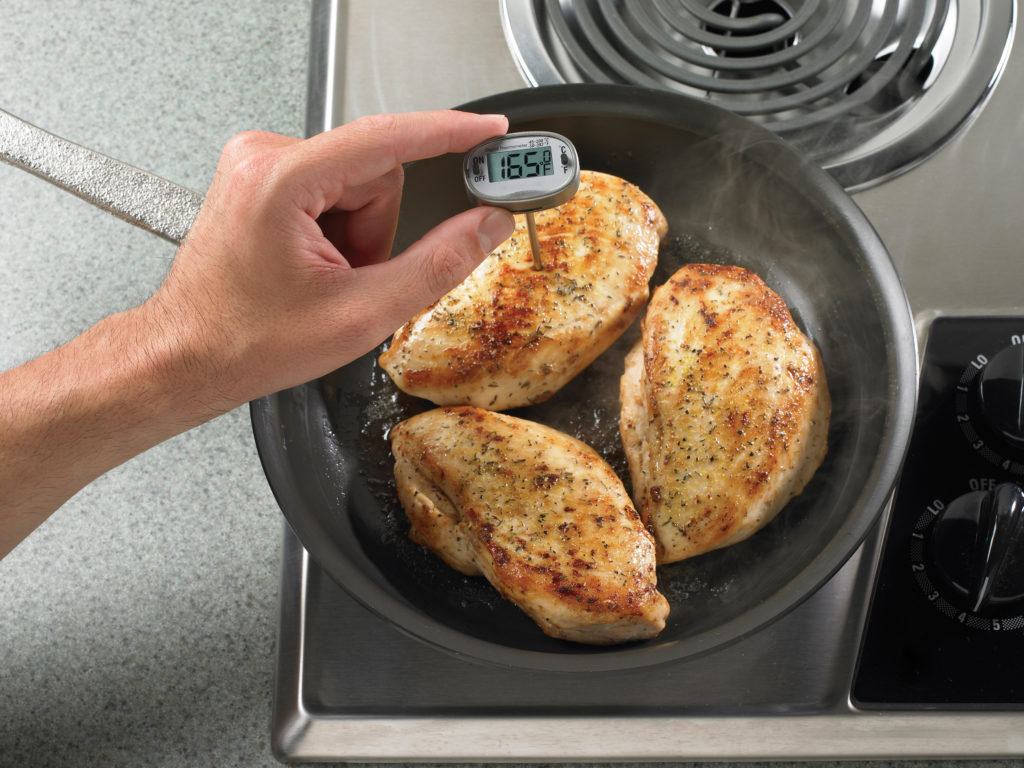Have you ever had food poisoning? Queasy stomach, chills, fever, diarrhea and vomiting are just a few of the symptoms people experience when they eat enough bacteria that grows on food that has not been cooked or chilled properly. If you haven’t had food poisoning, have you ever had the “24 Hour Bug” or “24 Hour Flu”? Chances are if you’ve had the “Bug”, it was food poisoning.
Did you know that one in six Americans could get sick from food poisoning this year? Each year food poisoning sends over 100,000 people to the hospital, mostly from foods cooked at home. All that time, money and suffering can be prevented by following four simple steps.

Clean
- Wash hands and surfaces often. Bacteria can survive in many places around the kitchen, including the refrigerator door handle.
- Wash fruits and veggies before eating, cutting or peeling. Bacteria and dirt can spread from the outside to the inside easily.
- Never wash meat, poultry or eggs. Washing these proteins can actually help bacteria spread because their juices can splash around your sink and onto your clothes.
Separate
- Use separate cutting boards for uncooked and ready to eat foods. Or make sure to wash and sanitize boards between uses.
- Keep meat, poultry and eggs separate from other foods at the grocery. Put raw meat and seafood in a plastic bag to prevent juices from spreading.
- Keep meat, poultry and eggs separate from other foods in the fridge. Store raw meat on a plate on the bottom shelf.
Cook
- Use a food thermometer. The only way to really tell if a food is ready to eat is by taking the temperature to see if it is high enough to kill bacteria. Here is a temperature chart!
- Keep food hot after cooking. Bacteria start to grow on food once it is cooler than 140 F.
Chill
- Refrigerate perishable foods within 2 hours. Harmful bacteria can grow to unsafe levels within 2 hours unless food is refrigerated.
- Freeze foods to extend their life. Freezing doesn’t destroy bacteria, but it does keep the food safe until you can cook it. If it was safe going into the freezer, it will stay that way!
- Never thaw food on the counter or in a sink full of water. Bacteria can multiply rapidly at room temperature. Always thaw foods on a plate in the refrigerator.
A sizeable percentage of food poisoning comes from eating food that has passed its safety zone. The chart below shows the recommended storage times for many food types.
|
Category |
Food |
Refrigerator (40 °F or below) |
Freezer (0 °F or below) |
| Salads | Egg, chicken, ham, tuna & macaroni salads | 3 to 5 days | Does not freeze well |
| Hot dogs | opened package | 1 week | 1 to 2 months |
| unopened package | 2 weeks | 1 to 2 months | |
| Luncheon meat | opened package or deli sliced | 3 to 5 days | 1 to 2 months |
| unopened package | 2 weeks | 1 to 2 months | |
| Bacon & Sausage | Bacon | 7 days | 1 month |
| Sausage, raw — from chicken, turkey, pork, beef | 1 to 2 days | 1 to 2 months | |
| Hamburger & Other Ground Meats | Hamburger, ground beef, turkey, veal, pork, lamb, & mixtures of them | 1 to 2 days | 3 to 4 months |
| Fresh Beef, Veal, Lamb & Pork | Steaks | 3 to 5 days | 6 to 12 months |
| Chops | 3 to 5 days | 4 to 6 months | |
| Roasts | 3 to 5 days | 4 to 12 months | |
| Fresh Poultry | Chicken or turkey, whole | 1 to 2 days | 1 year |
| Chicken or turkey, pieces | 1 to 2 days | 9 months | |
| Soups & Stews | Vegetable or meat added | 3 to 4 days | 2 to 3 months |
| Leftovers | Cooked meat or poultry | 3 to 4 days | 2 to 6 months |
| Chicken nuggets or patties | 3 to 4 days | 1 to 3 months | |
| Pizza | 3 to 4 days | 1 to 2 months |
Source: FoodSafety.gov
Written by Adriene Worthington, RDN, LDN
bacteria, food poisining, food safety, safety

